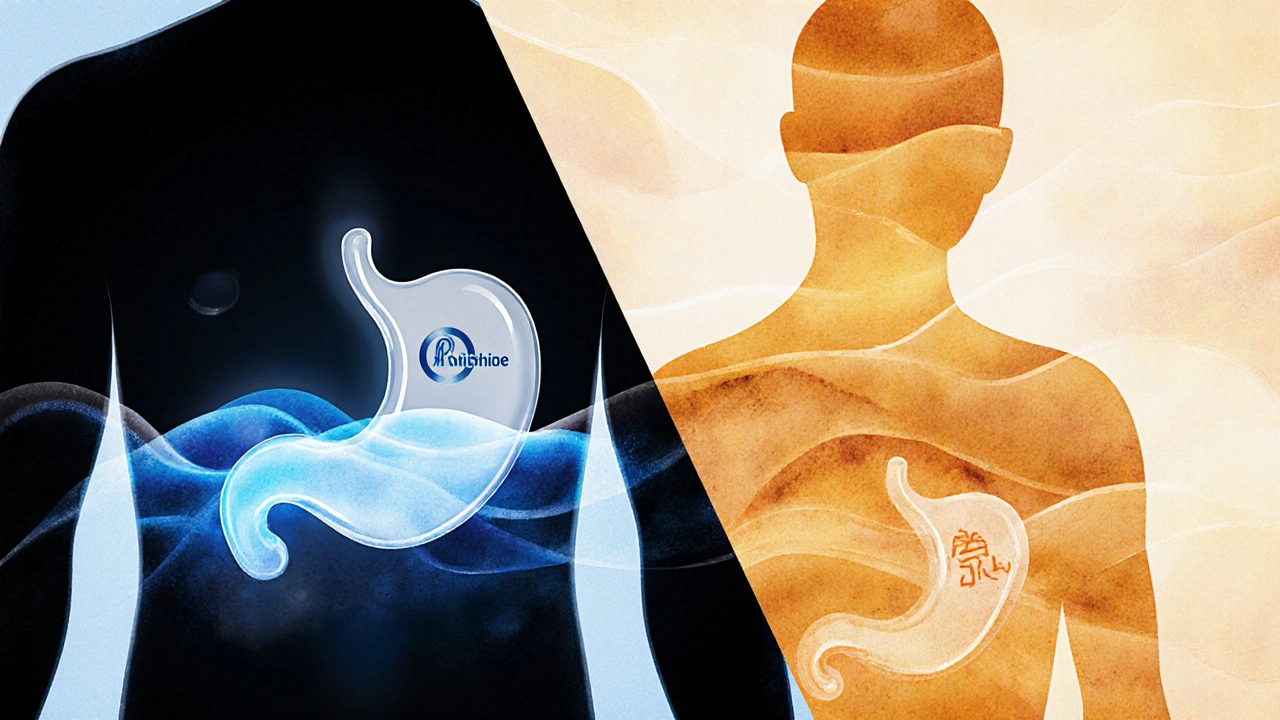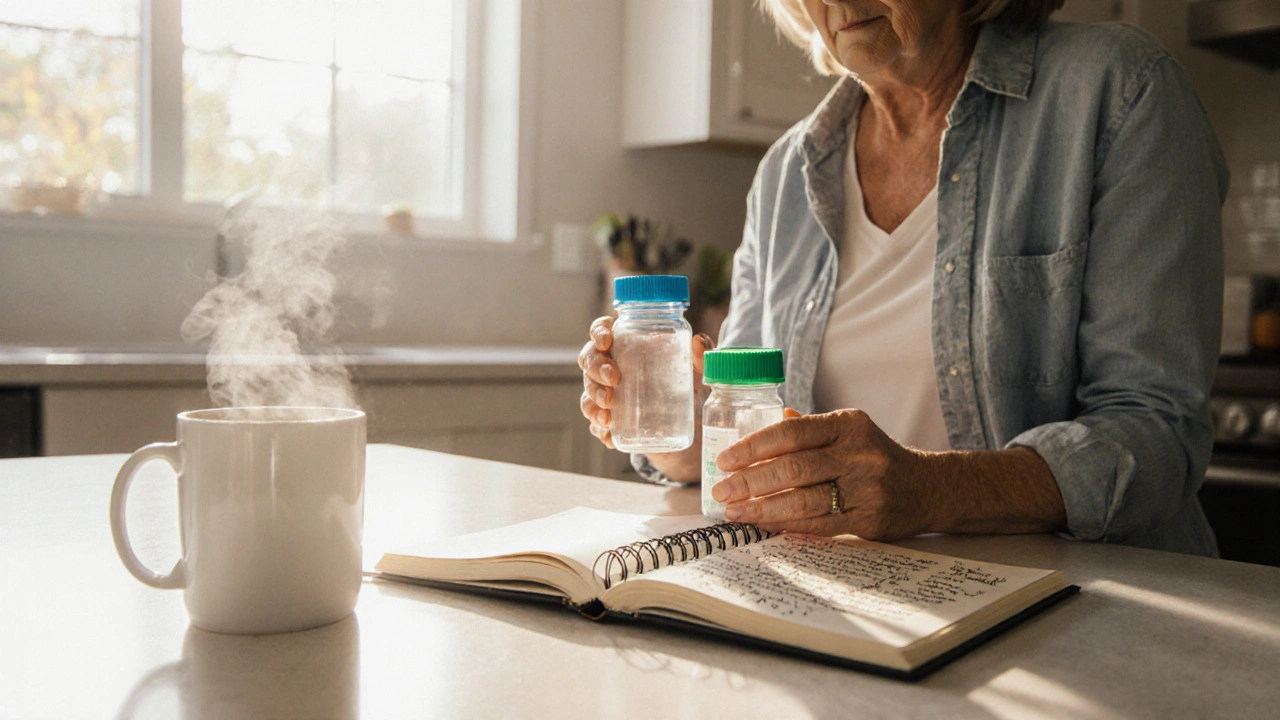Acid Reducer Comparison Tool
Select your condition and preferred medication class to see suitable alternatives:
Ranitidine is a histamine‑2 (H₂) receptor antagonist that reduces stomach acid production. First approved in 1983, it became a go‑to for heartburn, gastric ulcers and gastro‑esophageal reflux disease (GERD). In 2020 the FDA pulled it from shelves after NDMA contamination concerns, prompting patients and clinicians to search for safe Ranitidine alternatives.
Why Compare Ranitidine With Other Acid‑Reducers?
When a drug disappears overnight, you need a clear roadmap. The key jobs you’ll likely have after reading this article are:
- Understand how Ranitidine works compared to other H₂ blockers.
- Identify the safety profile differences, especially NDMA risk.
- Match your symptom severity to the right drug class (H₂ blocker vs. proton‑pump inhibitor vs. antacid).
- Learn dosing, onset, and duration for each option.
- Get a quick reference table to compare the top alternatives.
Mechanism of Action: H₂ Blockers vs. Proton‑Pump Inhibitors
All acid‑reducers target the final step of gastric acid secretion, but they do it differently. H₂ blockers, like Ranitidine, bind to histamine‑2 receptors on parietal cells, blocking one of the three stimulatory pathways (histamine, gastrin, acetylcholine). This yields a moderate decrease in acid, usually enough for mild‑to‑moderate GERD.
Proton‑pump inhibitors (PPIs) such as Omeprazole inhibit the H⁺/K⁺‑ATPase enzyme-the "pump" itself. The result is a more profound, longer‑lasting suppression, making PPIs the choice for severe erosive esophagitis or Barrett’s esophagus.
Safety Red Flags: The NDMA Saga
NDMA (N‑nitrosodimethylamine) is a probable carcinogen. Independent labs discovered that some Ranitidine batches formed NDMA when exposed to heat or certain preservatives. The FDA deemed the risk unacceptable, leading to a global recall.
Other H₂ blockers-Famotidine, Cimetidine, Nizatidine-have not shown the same NDMA issue under normal storage. PPIs have their own safety chatter (risk of bone fracture, kidney disease, possible infections), but they don’t carry NDMA concerns.
Direct H₂ Blocker Alternatives
Below are the main H₂ antagonists that still have a solid safety record.
Famotidine is a second‑generation H₂ blocker that offers a faster onset and lower drug‑interaction potential than older agents.
Cimetidine is a first‑generation H₂ antagonist known for its extensive cytochrome P450 inhibition, which can cause more drug interactions.
Nizatidine is a H₂ blocker similar to Ranitidine but with a slightly longer half‑life and no reported NDMA formation.
- Famotidine (20‑40mg twice daily) reaches peak effect within 1‑2hours and lasts about 10‑12hours.
- Cimetidine (300mg twice daily) peaks in 2‑3hours, duration roughly 8‑10hours, but beware of interaction warnings.
- Nizatidine (150mg twice daily) works in 1‑2hours and sustains acid suppression for 12‑14hours.
For most people who tolerated Ranitidine, switching to Famotidine is the easiest swap-same dosing schedule, fewer interaction worries, and no NDMA alarm.

Proton‑Pump Inhibitor Alternatives
When symptoms are more severe or chronic, a PPI often provides better control.
Omeprazole is a first‑generation proton‑pump inhibitor that irreversibly blocks the gastric H⁺/K⁺‑ATPase pump.
Esomeprazole is a the S‑enantiomer of Omeprazole, offering slightly higher bioavailability and more consistent acid control.
Lansoprazole is a a PPI with a rapid onset, often used for healing erosive esophagitis.
- Typical dose: Omeprazole 20mg once daily (or 40mg for severe disease).
- Onset: 1‑2hours, but maximal effect may take 3‑5days of continuous use.
- Duration: up to 24hours of acid suppression per dose.
PPIs are generally safe for short‑term use (<12weeks). For long‑term maintenance, doctors may rotate to an H₂ blocker or add a low‑dose PPI to reduce potential side effects.
Antacids & Lifestyle Adjuncts
Sometimes a quick fix is all you need.
Calcium carbonate is a fast‑acting antacid that neutralizes stomach acid within minutes.
Antacids work instantly but only last 30‑60minutes. They’re great for occasional heartburn after a big meal but not for chronic GERD.
Combine medication with lifestyle tweaks: elevation of head while sleeping, avoiding late‑night meals, limiting caffeine and alcohol, and losing excess weight. Those changes often enhance drug effectiveness.
Quick Reference: How Do They Stack Up?
| Medication | Class | Typical Dose | Onset | Duration | FDA Status (2025) |
|---|---|---|---|---|---|
| Ranitidine | H₂ blocker | 150mg twice daily | 1‑2h | 8‑10h | Withdrawn - NDMA risk |
| Famotidine | H₂ blocker | 20‑40mg twice daily | 1‑2h | 10‑12h | Approved - No NDMA issues |
| Cimetidine | H₂ blocker | 300mg twice daily | 2‑3h | 8‑10h | Approved - Interaction caution |
| Omeprazole | PPI | 20mg once daily | 1‑2h (max effect 3‑5d) | ~24h | Approved - Standard of care for severe GERD |
| Calcium carbonate | Antacid | 500‑1000mg as needed | Minutes | 30‑60min | OTC - No prescription needed |
How to Choose the Right Option for You
Use this simple decision tree:
- If you need quick relief for occasional heartburn → try Calcium carbonate after meals.
- If you require daily control of mild‑moderate symptoms → switch to Famotidine (or Nizatidine) and monitor for side effects.
- If your doctor diagnosed erosive esophagitis, Barrett’s, or severe GERD → a PPI such as Omeprazole or Esomeprazole is usually recommended.
- If you have a history of drug interactions (e.g., warfarin, phenytoin) → favor Famotidine over Cimetidine.
- If you are pregnant or breastfeeding → consult your clinician, but H₂ blockers (Famotidine) are generally considered safer than PPIs.
Always discuss dosage changes with your healthcare provider, especially if you’ve been on acid‑reducers for more than a month.
Related Concepts & Next Steps
Understanding Ranitidine’s place in therapy leads naturally to a few adjacent topics you might explore next:
- GERD diagnostics - endoscopy, pH monitoring, and the Lyon Consensus.
- Long‑term PPI management - tapering strategies, calcium supplementation, and infection risk mitigation.
- Drug‑food interactions - how meals affect the absorption of H₂ blockers vs. PPIs.
- Emerging therapies - potassium‑competitive acid blockers (e.g., vonoprazan) as a newer class.
These topics round out the broader “acid‑reduction” cluster and help you keep a holistic view of digestive health.

Frequently Asked Questions
Is Famotidine a safe substitute for Ranitidine?
Yes. Famotidine works the same way-blocking H₂ receptors-but it has a cleaner safety record with no known NDMA formation. Dosage is usually 20‑40mg twice daily, and it interacts with fewer drugs than Cimetidine.
Can I use an over‑the‑counter antacid instead of a prescription H₂ blocker?
Antacids like Calcium carbonate give rapid relief but only last an hour or so. They’re fine for occasional heartburn, but for daily symptoms or ulcer healing you’ll need an H₂ blocker or a PPI.
Why were PPIs once thought to be safer than H₂ blockers?
PPIs suppress more acid, so they reduce the risk of ulcer complications. However, long‑term use has been linked to bone fractures, kidney disease, and infections, so safety depends on duration and individual risk factors.
What should I do if I’ve been taking Ranitidine for years?
Stop using Ranitidine immediately. Talk to your doctor about switching to Famotidine or a low‑dose PPI. If you’re worried about past NDMA exposure, discuss cancer screening options based on your age and risk profile.
Are there any dietary changes that enhance the effect of H₂ blockers?
Avoid large meals close to bedtime, limit caffeine, alcohol, and spicy foods. Elevating the head of the bed 6‑8inches can also reduce nighttime reflux, making medication work more efficiently.


Julius Smith
September 27, 2025 AT 14:06Wow, looks like the pharma guys just yanked Ranitidine off the shelves, classic 🙄💊. Guess we all have to learn the hard way about hidden chemicals!
Brittaney Phelps
September 27, 2025 AT 16:56Switching to famotidine is a safe and easy move for most patients.
Kim Nguyệt Lệ
September 27, 2025 AT 20:00The article correctly distinguishes between H2 blockers and PPIs. It also clarifies that NDMA contamination has not been reported in famotidine or nizatidine. This information is valuable for clinicians.
Rhonda Adams
September 27, 2025 AT 23:20Great summary! 😊 If you’re unsure which option fits you, talk to your doctor about symptom severity and any other meds you take.
Macy-Lynn Lytsman Piernbaum
September 28, 2025 AT 02:40Isn’t it wild how a drug that’s been around since the 80s can just disappear overnight? It makes you wonder about the fine line between innovation and oversight 😅. When Ranitidine was taken off the market, a lot of people felt blindsided, but the underlying chemistry tells a story of molecules reacting to heat and storage conditions. NDMA, that sneaky nitrosamine, isn’t something manufacturers set out to create; it’s a by‑product of degradation, yet the health implications are serious enough to cause a recall. The replacement options-famotidine, cimetidine, nizatidine-each have their own quirks, but none have shown the same NDMA issue under normal conditions. PPIs, on the other hand, bring a different set of concerns, like potential bone density effects and infection risks, but they don’t have the NDMA cloud hanging over them. So the real question becomes: are we swapping one set of risks for another, or are we truly moving toward safer therapy? For many patients, the answer lies in matching severity of symptoms to drug potency-mild GERD may be fine with an H2 blocker, while severe erosive disease often needs a PPI. It’s also a reminder that medication choices aren’t static; they evolve with new data and regulatory actions. Pharmacists and clinicians must stay informed, and patients should feel empowered to ask why a change is being recommended. Ultimately, the goal is to keep the gut calm without introducing new hazards, and that balance is a moving target. Keep an eye on updates from the FDA and your healthcare team, and don’t hesitate to discuss any lingering worries. 🌟
Alexandre Baril
September 28, 2025 AT 06:00I hear your frustration. The NDMA issue was linked to how ranitidine breaks down under heat, not a deliberate addition. Manufacturers decided to pull it to protect patients.
Stephen Davis
September 28, 2025 AT 09:36That philosophical spin is spot‑on, Maya. 😎 While we’re debating NDMA, let’s not forget that famotidine offers a rapid onset with minimal drug interactions-perfect for those who can’t tolerate PPIs. And if you need a longer window, nizatidine steps in with a half‑life that keeps the acid at bay for up to 14 hours. Your point about risk‑vs‑benefit is the heart of personalized medicine, and it’s refreshing to see it laid out in plain English. Keep the dialogue rolling, because the more we unpack, the better choices we make.
Grant Wesgate
September 28, 2025 AT 13:13Nice breakdown, Kim. 👍 The distinction between H2 blockers and PPIs is key for anyone looking into alternatives.
Richard Phelan
September 28, 2025 AT 17:06While Breezy’s one‑liner sounds helpful, let’s not gloss over the ethical fallout of a pharmaceutical giant pulling a drug without transparent communication. The public deserves more than a quick “switch to famotidine.” It’s a moral imperative to demand rigorous testing and honest reporting. Short‑term convenience shouldn’t eclipse long‑term safety.
benjamin malizu
September 28, 2025 AT 21:00The ontological ramifications of substituting a histamine‑2 antagonist with a proton‑pump inhibitor invoke a cascade of pharmacodynamic variables. From a pharmaco‑epidemiological perspective, the incidence rate ratio of adverse renal outcomes escalates when shifting from famotidine to omeprazole, particularly in polypharmacy cohorts. Hence, a judicious appraisal of risk‑benefit matrices is indispensable.
Louie Lewis
September 29, 2025 AT 00:53Sure you trust those “official” studies they hide behind the curtain of regulatory bodies they’ve funded there’s a pattern of suppression of truth “